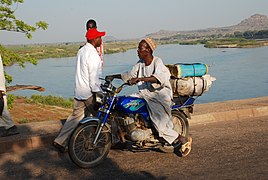Maroua
| Maroua | ||
|---|---|---|
|
|
||
| Coordinates | 10 ° 36 ′ N , 14 ° 20 ′ E | |
| Basic data | ||
| Country | Cameroon | |
| Extreme north | ||
| district | Diamaré | |
| ISO 3166-2 | CM-EN | |
| height | 400 m | |
| Residents | 205,635 (2005) | |
|
One street in Maroua
|
||
Maroua is the capital of the Cameroonian region of Extrême-Nord and of the Diamaré department . It is located at an altitude of 400 m on the Ferngo and Kaliao rivers . According to an estimate from 2005, the city has 205,635 inhabitants.
history
Until the end of the 18th century, Maroua was an old central place of the Guiziga , which since the immigration of the Fulbe into what is now North Cameroon have been increasingly pushed back to the outskirts of the mountainous regions. In 1791/92 the Fulbe under the leadership of Moodibbo Muhamman Selbe used internal power struggles of the Guiziga to occupy Maroua and expanded it into their northernmost outpost in the region. As early as the beginning of the 20th century, the city's population is said to have been 30,000. Under the rule of the Fulbe it became the residence of a Subamirate dependent on the Amir Fombina in Yola .
In December 1893 the city was visited by the German explorers Edgar von Uechtritz and Siegfried Passarge . In January 1901, in the battle of Miskin-Maroua near Miskin south of Maroua, a division of the German protection force under the leadership of Lieutenant Hans Dominik defeated the army of Amir Djubayru b. Aadama . The reigning Ardo of Maroua, Aaamadu Rufaa'i, fled with Djubayru before the German occupation authorities, which in turn initially began his brother Abdurraamaani Suyuudi governor and later under the name Suudi to Lamido appointed. Under German protection, he succeeded in expanding his sphere of influence at the expense of the autochthonous population in the wider area.
During the German colonial period , Maroua (German Marua) belonged to the Adamaua residency . In 1913 the city temporarily became the seat of a German officer post. Incidentally, the influence of German colonial rule remained comparatively small. After the First World War, Maroua became part of the French mandate.
Economy and Infrastructure
economy
The Maroua market is one of the most important in Cameroon. The city is also a center of the cotton industry and is home to the Maroua Technical Center (Center Technique de Maroua, CTM) and the Saare Tabitha training center for young women.
traffic
The city has an international airport . Asphalt roads lead north to Mora and south to Guider . As the regional center of the region, Maroua is also connected to the other cities of the Diamaré by a network of year-round ski slopes.
education
The University of Maroua is based in the city.
religion
Three quarters of the population of Maroua (74.6%) belong to Islam. Christianity is the second largest religion with over 20%. In the surrounding villages there are still many followers of traditional African religions such as animists, but hardly any in the city itself.
Tourism and sightseeing
Maroua is known nationwide for its handicrafts. On the market square, the Diamaré Museum shows art and handicrafts from the ethnic groups of North Cameroon (Mousgoum, Massa, Kapsiki).
- Transportation in the city
In the north is the Waza National Park . To the west of the city is Mokolo with its reservoir. From there you can reach the village of Rhumsiki in its famous volcanic landscape further west , right on the Nigerian border.
Climate table
| Maroua | ||||||||||||||||||||||||||||||||||||||||||||||||
|---|---|---|---|---|---|---|---|---|---|---|---|---|---|---|---|---|---|---|---|---|---|---|---|---|---|---|---|---|---|---|---|---|---|---|---|---|---|---|---|---|---|---|---|---|---|---|---|---|
| Climate diagram | ||||||||||||||||||||||||||||||||||||||||||||||||
| ||||||||||||||||||||||||||||||||||||||||||||||||
|
Average monthly temperatures and rainfall for Maroua
Source: wetterkontor.de
|
|||||||||||||||||||||||||||||||||||||||||||||||||||||||||||||||||||||||||||||||||||||||||||||||||||||||||||||||||||||||||||||||||||||||||||||||||||||||||||||||||||||
literature
- Eldridge Mohammadou: L´histoire des Peuls Férôbé du Diamaré, Maroua et Pétté , Tokyo 1976
- Jeanne-Françoise Vincent: Données nouvelles sur la fondation et le peuplement de la chefferie de Marva (North Cameroun) , in: Shohei Wada, Paul K. Eguchi: Africa 4, Osaka 1992, pp. 481-501
- Reinhard Kapfer : The women of Maroua: Love, sexuality and marriage in North Cameroon , Peter-Hammer Verlag 2005








